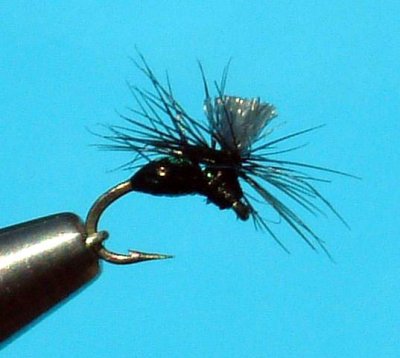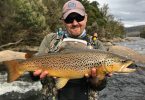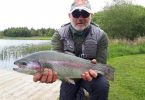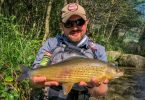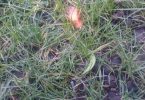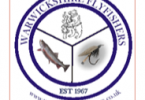Our River "Chironomid" I regard to be the smaller cousins of the "Stillwater" variety possibly because the density of population in the acidity of the streams and rivers of North Wales is such that the minuscule food items available for them stunts the growth, whereas in the richer Stillwaters the balance of food items is better and the Nymph, Pupae and Adult grow larger.
I have often heard of this little insect being described by anglers as "The Black Gnat", where in fact it is not; maybe the slim and sparse tying of some artificial patterns commercially sold as “Black Gnat” has been mistaken to be a representative of the "Chironomid", or is it may be that the name is easy to remember. I have no wish to turn this matter of identification of various insects as against the artificial into an issue, they are only words anyway and trout do not eat words do they!!, but for the record the actual "Black Gnat" as I know it is a cousin of the "Hawthorn Fly" with the Latin name of (Bibio johannis) and the Insect that I wish to bring to your attention is the "Chironomid".

A couple of years ago now on the upper reaches of the River Dee I got caught out in a show of "Chironomids", I am being careful not to say "hatch" because it could have been a mixture of both "Adult" returning to lay their eggs and “Nymph’s" turning into "Adults", I was caught out good style though with hundreds of "Trout" and "Grayling" on the fin picking off the "Adult?" "Nymph?" as they floated past, but made little progress in apprehending them with my offerings. I covered small sections of "Grayling" identifiable by the flash of steely blue sheen of the upper back and the vermilion of the dorsal fin at each rise, absolute magic to watch at close quarters, I just failed miserably to connect with fish after fish covered again and again.
When you are up to your waist in water on a glide and approach from a downstream position to the feeding area, slowly and careful, you can actually become part of the scenery as far as the Grayling are concerned they will ignore you and with the aid of Polaroid glasses you can even see the spots on the Dorsal fins as they break the surface to engulf eagerly at the continual conveyor belt of food items floating by, to me this is one part of what fly-fishing is all about.
Try as I did with "Dries" and "Nymphs" of various black and dark patterns, down to size 20, fished upstream, downstream, in the film, high floating, just under, the results can at best be described as mediocre tailing out to complete failure with certain pods of fish totally ignoring the artificial offerings in and amongst the naturals whilst others showed interest inspecting the offering but turning away at the last minute. This lasted off and on for a period of two hours until the wind picked up and the temperature dropped, the rise was over which left me quite bewildered as to what I had to do to succeed. The cover over the "Experience” switch is removed and "Brain" engaged.
One lesson in Fly-fishing which is particularly important to success in the art is attention to detail at every stage of failure, one learns nothing from catching fish after fish when you have got it right, this only leads one into a false sense of security, the important aspect is to overcome a difficult situation analyze what you are doing and closely examine what the fish are doing also, it is through this period of the equation that you will come to understand the intricacies and importance of "attention to detail", as I was to do that day.
I left the Rod on the bank and waded into an area where the fish had been active, taking my small meshed landing net with me. By pulling the length of the mesh together to make it even smaller and tighter and holding it in the surface film I was able to trap the floating insects and closely examine them, well for a few seconds before they fluttered away.
Slim "Chironomids" no more than 1/4" long, I had a feeling that my presentation of the artificial was right as many fish were seen examining the offerings at close quarters, but something was wrong, continuing the search of the surface film was to be the answer to my despair, in and amongst the hundreds of floating "Chironomids" was another type of "Chironomid" and I hazard a guess (remember I am not an entomologist) at a female "Chironomid" maybe, one laden with a bulbous abdomen possibly full of eggs, or was it a greedy Male that had overindulged from the larder, the question I needed answering was had the fish recognised the fact that by taking the bulbous "Chironomid" the intake of goodness was twice as profitable to their well being as against the effort put in to rising for the slimmer "Chironomid", an answer that has to be left with the fish, but one to consider in the cold light of day when failure is looming.
Closer examination of the water surface as the insects floated past was to help me decide that was the case although you had to strain your eyes to identify the Bulbous "Chironomid" in the surface film as they passed by, once you picked one out and followed its course it was not long before the fish intercepted it although there were more Slim "Chironomid" in the same area the fish selected their preference. From experience, I was not convinced that I had the answer but at least I had learned something new.
Back home that evening I made a point of tying a Parachute version of a "Chironomid" with a bulbous abdomen, which was simply a build up of tying thread which I varnished to create that sheen which the natural displayed, this was on a size 18 hook, I also went a step further just incase some of the fish were taking the nymph in the ascending stage, using stripped peacock herl varnished to strengthen, with two turns of fine unstripped herl as the thorax.
Next day after lunch with a cautious unconvinced approach I was at the River again and sure enough before I wet the line I waded in and watched for the Bulbous "Chironomid", knowing what I was looking for it was not long before I witnessed the same behavior from the fish as I had seen the previous day. Three casts and three fish confirmed that my analysis and resulting pattern change had been worth the time and effort and I had another string to my bow, or so I thought, sport was fast and dream like.
The main part of the lesson is simple when I believe I know it all, I will think again. My advice to you is only meant as a thought teaser from the realities of my experiences, good luck is another extremely important factor and we all need that.
The little "Dry Fly" featured is tied on a size 18 Mustad 80250 Hook. Black Multistrand tying thread, wound on and overwound (back and too) along the body to create a bulb
ous abdomen. This is then half hitched and trimmed and the whole body is varnished to strengthen and create that sheen to copy the natural. This is allowed to dry, I do mine half dozen or so at the time. When dry it is returned to the vice and the tying thread applied to the thorax area and secured. A piece of Grey Colored Antron Bodywool is then tied in so it can be used as a pole for the hackle, I find Grey more suitable as it copies that lead/ white colour of the natural wing and in use, in and amongst white speckled froth on the river I can pick it out. This is put into the jaws of hackle pliers and tightened up onto the Gallows Tool. I select a fine black cock hackle and tie in with the tying thread at the base of the pole of Antron by the stalk and using another hackle pliers take the hackle around the antron in tight turns up and then back through and down to the hook shank where I trap it and tie it in before trimming the surplus, I then build up a small neat head and use a dab of Superglue off the dubbing needle to secure, I also after trimming the pole to suit the size of the hook and fly, push the needle through the Antron at the point where the hackle reaches the top, this prevents it from unraveling in the casting action and makes for a more robust pattern.
Good luck at your next outing and let us know how the pattern works for you!
Gwilym Hughes (APGAI)
You can find a wealth of interesting information on Gwilym’s background, along with details on his tutorial videos and tutoring services at: http://www.gwilymhughes.com
Got a flyfishing question you’d like to ask Gwilym? Please email us and we’ll pass it on.

